|
Emerson

In 1876
a steam grist mill, with two run of stone, was built in Emerson by Mr.
Charles Borrow. Press reports indicate that the HBC renovated a large
Flour Mill in 1884 . At various times a mill called the Stauffer Mill,
and ones owned by Fraser & Co. and Pocock & Sons were in
business.
In 1881
Messrs. Carney & Watson built a sawmill which had the capacity of
turning out 25,000 feet of lumber per day, using hard wood taken from
their own timber, located on the Red River, a few miles south of
town.
Noble
and Follis manufactured common lumber, doors, sash, blinds. Their
factory was located on Main Street, and consisted of one building 24x54
feet in area, with two flats; also an, addition of 16x50 feet. They
employed about twenty-five hands.
Edward
Sabin & Co. were general carriage, sleigh and cutter
manufacturers. In connection with their manufacturing they
conducted a general blacksmithing, shoeing and repair shop.
Press
Clips
S:
Commercial, September 4, 1883, p. 413.
“The Hudson Bay Company have
decided to reopen their large flour mill here. Water is to be supplied
the mill from a drain from the river up which water will be forced by
windmill power. A warehouse with a capacity of 12,000 bushels is to be
built alongside the mill. The company will also build a 20,000 bushel
elevator at the station.”
S:
Nwfmm, October 1883, p. 254.
“The HBC are building a large grain
storehouse next to their mill at West Emerson.”
S: AM,
January 1, 1884, p. 28.
“The addition to the Hudson Bay Company’s mill
at Emerson, Manitoba, is nearly completed. It is proposed to convey the
water supply from the Red River by means of a trench to a reservoir
beneath the mill.”
S:
Commercial, July 8, 1884, p. 805.
“The Emerson steam grist mill
commonly known as Stuaffer’s Mill, was sold on the 2nd inst., under a
foreclosure of mortgage, and was purchased by Mr. Curran for $4,220. It
will be put in operation of Monday the 7th.”
S: AM,
August 1, 1884, p. 430.
- “Stauffer’s Mill”, at Emerson, Manitoba, was
sold July 2 under a foreclosure of the mortgage. It was purchased by
Mr. Curan for $4,220. It was put in operation July 7.”
S: AM,
April 1, 1885, p. 194.
“At Emerson, Manitoba, on Mach 30, James Watson
was killed by the bursting of the fly-wheel of a grain crusher, and Mr.
Van Wert was wounded in the arm.”
S:
Nwfm, January 1892, p. 24.
“Fraser and Company’s grist mill at Emerson,
Manitoba is running to its fullest capacity.”
S:
Commercial, 8th Annual Supplement, p. 634.
- Owner: Fraser and Company
with 300 barrel day capacity.
S:
CMGE, March 1910, p. 75.
- “The German Milling Company has bought
Pocock and Son’s mill at Emerson, Manitoba.”
West Lynne
West
Lynne Charter for the incorporation of West Lynne was granted in l882.
The town was laid out twenty four blocks long and three and one half
blocks wide.
West
Lynne boasted of four general stores; six hotels and a brewery, where a
six quart pail could be purchased for fifteen cents. They also had a pop
factory and a cheese factory.
Press
reports indicate several flour mills operated for a time.
Press
Clips
S:
HBCA, D.20/16 – 1880.
- J. Ogden Grahame to J.A. Grahame, May 5, 1880,
fo. 139 – mentions memo regarding new mill to be built there.
- C.J.
Brydges to J.A. Grahame, May 6, 1880, fo. 141 – regarding erecting mill
and granary: "I am satisfied it is better than letting anyone else do
it and it will materially help your store and the place and
surroundings generally."
- J.H. McTavish to J.A. Grahame, July 5, 1880,
fo. 441 – laid out sites for mill and granary at West Lynne: "the same
as those chosen by yourself ;" Kenway received only 1 tender for $5,000
which shouldn't be accepted until estimate made."
S:
HBCA, D.20/23 – 1882
Ronald McLaren (St. Boniface) to J.A. Grahame,
June 15, 1882, fo. 144
- offer to move "flouring mill" at West Lynne
and Erect same on a new site about 300 feet from its present position
as specified in advertisement;" 20 feet addition to end of building;
new engine room; sink well; for $8,860.00.
- fo. 149 – copy of call for
tenders
Charles Esplin to J.A. Grahame, June 17, 1882, fos. 150-155 –
tender
- D. Matheson (W.L.) to J.A. Grahame, June 20, 1882, fo. 164 –
Emerson mill offering 95 cents per bushel; Ogilvie Company paid $1 for
2000 bushels delivered at Emerson station.
S:
HBCA, D. 20/25 – 1883
D. Matheson to J.A. Grahame, January 5, 1883,
fos. 6 and 6d
- This fall when the mill was being re-erected I had two
wells sunk to the depths of 24 and 30 feet, getting water in both cases
at 12 feet but not in sufficient quantity to run the mill and I have
not the means of going deeper. A supply could have been brought from
the River at an expense (before frost set in) of $700.00, but as you
were absent I did not feel at liberty of going to the expense."
- mill
is idle; feels bad grain would prevent profitability in any case; "and
now that grains are being run on the Pembina Mountain Branch of the
C.P.R. all the Western grain hitherto sold here, will be marked at
Smuggler's Point and other stations along the line."
S: G.F.
Tennant (Mayor, West Lynne) to J.A. Grahame, March 20, 1883, fos.
266-267 - urges Company to operate mill or leave it; present mill
prevents others from operating
S:
HBCA, D. 20/31, 1884.
D. Matheson to J. Wrigley, November 10, 1884, fo.
24 – took possession of mill on a "landlord's warrant"; to be put up
for sale; engineer wishes lease transferred to him, "but he thinks the
conditions are too exacting and the rent too high."
"It is
reported that the Hudson's Bay Company's mill, at West Lynne, will be
remodelled to the roller system."

Manitou &
Manitoba City

Manitoba
City
Manitoba
City was yet another ambitiously named community. By 1883 it had become
a roaring town with six licensed hotels, two liquor stores, five livery
stables, three lumber yards, a Medical Hall which housed the drug store
but also held offices for out of town doctors and other businessmen to
set up appointments, an undertaker, and numerous grocery, hardware and
implement outlets. Seven Justices of the Peace were appointed in an
attempt to keep the boom town under control.
Alas
a bit of a turf war, worthy of a modern industrial intrigue movie,
ended with Manitoba City giving way to its rival Manitou – a competing
village located just on the other side of the new railway line.
The
story, involving, land speculators, sharp lawyers, crooked CPR
managers, and a general assortment of shady deals, is well told on
several of the Manitou local histories.
Like
quite a few boomtowns – it had a grist mill – but the life of the town,
and thus the mill, was short.
Manitou
In 1881
John McIntosh started a small mill at Norquay, north of Swan Lake and
in 1893 moved the mill to Manitou as Manitou Roller Mills.
The
building was a black, two story, box-shaped structure. On the second
floor were a track and push-car and a storeroom. The bags of feed and
flour were placed on the moved to the chute on the south side o f the
building. The customer's vehicle backed under the chute and the bags
slid down.
The
local newspaper reported: “Any institution that is a means of drawing
trade to a town is of necessity an important factor in the prosperity
of that town.“
Business
from a wider radius gravitated to Manitou. Farmers could deliver wheat
to the mill, drop milk off at the cheese factory, exchange eggs and
butter for groceries at the store of their choice, have a square meal
at the hotel for a few cents, spend an afternoon catching up on news
around the stove at the livery barn, then late in the day pick up flour
ground from their own grain. They usually took home the bran and shorts
to be made into mash for the livestock. Screenings from the cleaner
provided fuel for the mill along with cordwood brought in exchange for
milling services. Often no money needed to change hands.
Revisions
included a new seventy horsepower boiler, all that was needed to keep
the mill up to date.
An ad
from 1899 stated: Manitou Mills - Grinding done promptly, Chopping on
Wednesdays and Saturdays. Best Hungarian Flour - $1.80. Best Strong
Bakers Flour - $1.60.
A Mr.
Whiteford operated it until the early 1920's when it was closed.
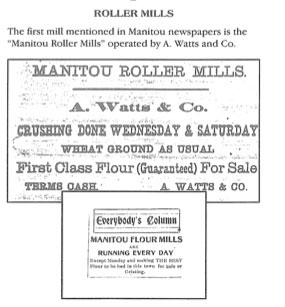 This
ad appeared in the Manitou paper in 1885. We don’t know if John
McIntosh bought it, or whether it had already ceased operation. Either
way, the name lived on
This
ad appeared in the Manitou paper in 1885. We don’t know if John
McIntosh bought it, or whether it had already ceased operation. Either
way, the name lived on
Darlingford

Along
the old Boundary Trail, at a point just west of Calf Mountain,
there was a conveniently flat spot on the Little Pembina that made a
good crossing. As often happened at crossings, a small village sprang
up. This one was called Darlingford. Like so many other villages it
started at one spot and re-started at another when the railway arrived.
In the meantime it served the needs of travellers and settlers,
providing some necessities. Along with stores, stopping places
and a post office, there was a saw and grist mill was run by thye
Findlay Brothers.
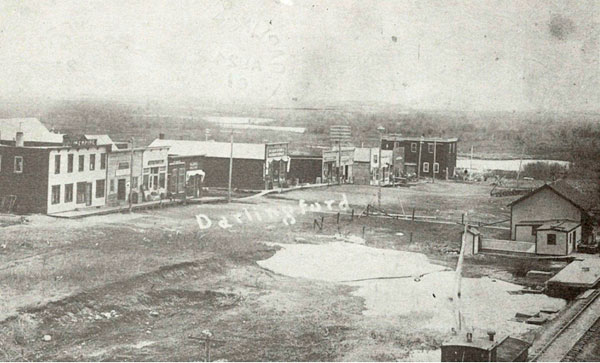 Darlingford
1909
Darlingford
1909
The new
site of Darlingford grew quickly along the railway line. Along
with the usual stores and services there were two brickyards. About
1898 Whalen’s Brick & Tile operated just west of the village. It
must have been quite an operation for the CPR ran a spur out to the
site, and he employed about ten people for a time. Although the bricks
were of a good quality, the operation didn’t last.
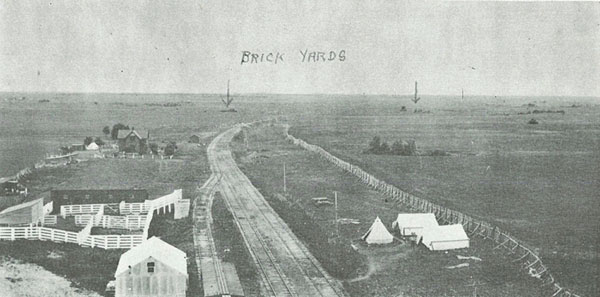
A photo shows the brickyard location.
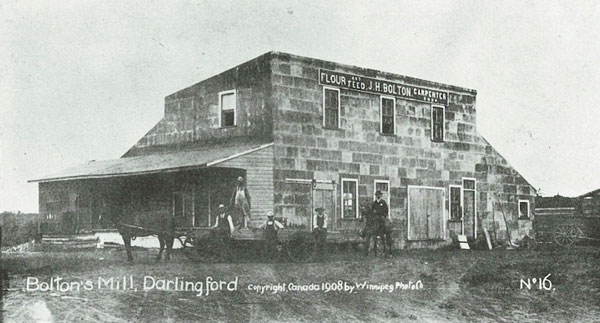
Bolton’s Mill
S:
Nwfmm, Special Ed., 1883, p. 20.
“Darlingford, one of the rising
towns on the south-western railway, is to have a $100,000 company to
erect an elevator, mill, and warehouse. The elevator will have a
capacity of 50,000 bushels, while the mill will be similar to that of
the Assiniboia Milling Company at Portage la Prairie.”
S: AM,
October 1, 1884, p. 543.
“The grist mill at Darlingford,
Manitoba, at present under the management of H.N. Fleming, has been
purchased by Joseph Ritchie, of Nelson, Manitoba, who will put it in
thorough working order.”
S: AM,
June 1, 1885, p. ____.
“The burr mill now at Darlingford,
Manitoba is about to be removed to Morden, Manitoba.”
S: The
Darlingford Saga, p. 24.
“There were a number of business places
a saw mill and grist mill was run by Findlay brothers. Circa 1875-1882
in Old Darlingford.”
S: CH,
Darlingford, p. 39.
- Photo 1908 of Bolton’s Mill with
commentary; burned May 1912.

Morden,
Winkler & Altona

Morden,
Winkler and Altona were railway towns, part of the second wave of
community building. As such, the emphasis on gristmills, cheese
factories, brickyards and sawmills was not as pronounced. From the
start they had links to supplies and to market that made these local
enterprises less of a priority. While gristmills did thrive in
these larger communities, they did so on the basis of commercial
viability, not in terms of essentials for subsistence. Of course a time
went on other industries, more associated with modern and urban
communities, did thrive.
Their
respective histories are well documented and we will present here a
sketch of the early operations that did exist.
Morden
The
first mention of a mill comes in when Anderson and McLean accepted the
bonus offered by the district and to erect a mill. In August of
1885 we learn that Ritchie and Lundy’s had completed a flour mill and
had it in in full operation.
In 1886
James H. Fraser, the proprietor of the Nelson flour mills, decided to
erect a roller mill in Morden. Mr. James Pye superintended the starting
of the machinery in December.
Mr.
A.E. Hughes, formerly with the Hudson’s Bay Company, Winnipeg,
Manitoba, was the head miller.
The Morden Flour Mill, built in 1900
MacGregor’s
brickyard was south of Morden and its products were used to erect
several substantial brick buildings, including the Dominion Post Office.
Press Items
S:
Nwfmm, February 1884, p. 36.
“We understand that Messrs. Anderson and
McLean, two practical men, have accepted the bonus offered by the
district and will erect a mill at that point, which will have three run
of stones and four sets of rollers.”
S: Commercial, August 11, 1885, p. 905.
“Ritchie and Lundy’s flour
mills, at Morden, has been completed and is now in full operation.
S: Nwfmm, January 1886, p. 355.
“Mr. James H. Fraser, the proprietor of
the Nelson flour mills, decided last summer to erect a first-class
roller mill in Morden, Manitoba, and for that purpose contracted with
the Pray Manufacturing Company of Minneapolis, Minnesota, for a
complete outfit for a mill of 75 barrels capacity, and in the mill as
completed, this well known firm have more than sustained their
reputation as builders offirst class mills. Mr. James Pye superintended
the starting of the machinery on the 17th December. Everything moved
off in a smooth and satisfactory manner.”
The
mill will be run to its full capacity night and day, there being a
large local and western trade for flour of all grades.
S:
Nwfmm, February 1886, p. 387.
“Mr. Ritchie, the proprietor of the stone
grist mills at Morden, Manitoba, has taken a partner. The firm is now
Ritchie and McIntyre.
S:
Nwfmm, April 1889, p. 100.
“J.H. Fraser, of Morden, Manitoba, is adding
new machinery from Minneapolis.”
Bricks
Winkler
The
“West Reserve”, established in 1876, was a treeless plain similar to
the Russian steppes from which the Mennonite settlers came. These
settlers established themselves in small villages of twenty to thirty
families. In December of 1882 the Canadian Pacific Railroad line from
Winnipeg to Manitou, created the town of Winkler.
Dyck
and Peters built the Winkler Grist Mill. I find no records of the fate
of that mill, but it seems likely that the Winkler Roller Mills
replaced that service.
Judging
by the several photos in “Winkler, A Proud Heritage”, it existed for
decades.
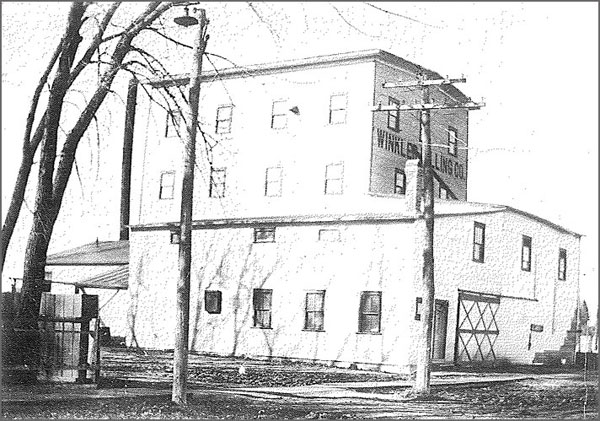 The
mill in Winkler
The
mill in Winkler
Press
Clips
S: CH,
Winkler: A Proud Heritage, 1982, Friesen, p. 78.
- 5 photos of Winkler
Milling Company Limited: 1) 1933 and 2) 1946 with the three others not
dated.
Altona
The
mills don’t play a big role in the Local History volumes of Altona but
they are mentioned.
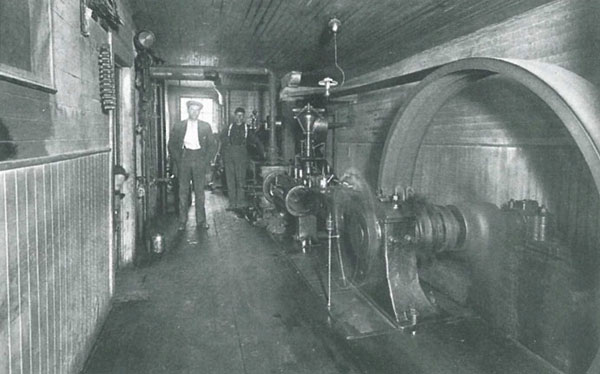 Mill
owners Isaac and David Fehr in the ”machine room”, which housed a steam
engine and this large pulley which drove the mill’s various cleaning,
grinding, and other machinery.
Mill
owners Isaac and David Fehr in the ”machine room”, which housed a steam
engine and this large pulley which drove the mill’s various cleaning,
grinding, and other machinery.
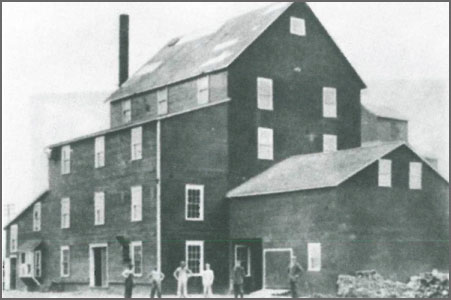 The
Altona mill in its heyday in the 1905 was the town’s main industry.
This photo shows the mill built by Peter Braun before the turn of the
century, when it was owned by David and Isaac Fehr, after the large
three-storey addition had been built.
The
Altona mill in its heyday in the 1905 was the town’s main industry.
This photo shows the mill built by Peter Braun before the turn of the
century, when it was owned by David and Isaac Fehr, after the large
three-storey addition had been built.
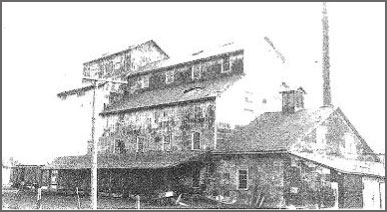 Friesen
Flour Mill around 1900. Owned then by Jacob. P. Friesen
Friesen
Flour Mill around 1900. Owned then by Jacob. P. Friesen
 La Riviere
La Riviere

The La
Riviere townsite was laid out in 1886. It became a divisional point for
the railway, so had a roundhouse and water tank.
A flour
mill was started by Cary and Grant, burned. J. Rockett built a cheese
factory beside Mary Jane Creek.
About
1902 a brickyard was established with a payroll of about thirty men,
including W. Carmichael as manager. He was followed by G.W. Dellar.
La
Riviere Press Brick & Tile Company
Adapted
from:
A
History of Brick Manufacturing in Manitoba 1860-1990
David
Butterfield 2018, Heritage Manitoba
In
1902, when tests made on local clay and shale deposits proved positive,
and the Press Brick & Tile Company, Ltd., owned by Elisha Frederick
Hutchings was established just to the east of town. A manager was found
in Minneapolis in May, and by the following month local workers were
being hired. By July, men had installed a brickyard dam, and a railway
spur to the site was nearly complete.
Early
in September the plant made its first bricks and was running “full
blast” by mid-month, with a kiln of 250,000 bricks being burned and
another 250,000 awaiting the fires. The following season (1903) saw the
firm invest $10,000 in erecting four new beehive kilns and other
improvements. Eleven cars of machinery were ordered, including an
engine, numerous castings, a blower, 100 dryer cars, and other
equipment. By late May the kilns were nearly complete, including an
arched subterranean passage linking all four. The large dryer with its
numerous brick divisional walls only lacked a roof at the time, but had
a 40-foot high stack.
Four
more kilns were under construction by mid-June. During mid-July, shale
was being taken from the hillside source by night blasting, and then
put on a carrier that took it down to the crusher where it was
pulverized into clay. Reports from the spring of 1905 show most of the
old employees back at work, and improvements included a remodeling of
the oldest kilns and the construction of a “lofty and strong” trestle
from the mill across the creek to the shale ledge.
In
January 1905, a number of men were at work at the brickyard, sorting
out and shipping the one million bricks on hand at the plant in
preparation for the coming season. But something had happened with the
firm’s financing, and the plant was suddenly up for sale . William
Brydon acquired control, and the next six years of the plant’s
operations are somewhat shadowy. In 1910 samples of brick “of a
beautiful colour and finish” were on display locally, and an
advertisement in July 1910 showed that the plant had acquired a new
manager— James Johnstone—as well as a new name: The Phoenix
Brick-works. In April 1911 it was noted that the plant machinery was
being fitted up, and a kiln was filled; given that there were at least
eight kilns, this appears to be a modest production schedule. It is not
clear if the plant was in operation in 1912, but it was sold in 1913,
to a Mr. Martin, who intended to renovate the complex, install new
machinery, and place it on a sound footing. But that did not occur, and
the plant was abandoned by 1914, as so many Manitoba plants were with
the oncoming war.
 A view,
ca. 1903, looking west showing the mixing and pressing building on the
left and the kilns of La Riviere’s Press Brick & Tile Company.
(Courtesy Turning Leaves. A History of La Riviere and District,
frontispiece)
A view,
ca. 1903, looking west showing the mixing and pressing building on the
left and the kilns of La Riviere’s Press Brick & Tile Company.
(Courtesy Turning Leaves. A History of La Riviere and District,
frontispiece)
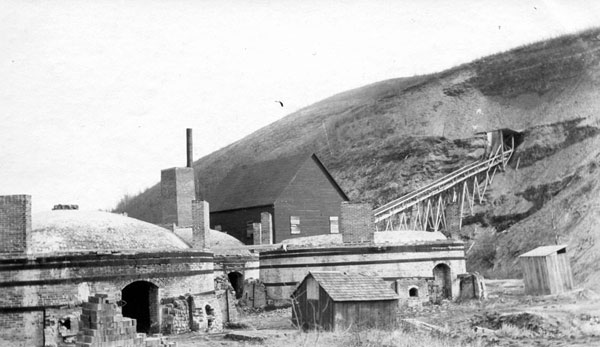
The La Riviere Brickworks, seen here ion 1907, was a large
operation involving a substantial investment in infrastructure.
The
shale deposits
on the hillside were drawn by rail cars down to the mixing and
brick-pressing building and then burned in one of the eight beehive
kilns. (Courtesy Archives of Manitoba)
 Killarney
Killarney

S: Commercial, 1893, p. 634.
“At Killarney, on the Deloraine Branch, a
new mill of 100 barrels capacity, has recently been put in operation by
Young Brothers and Buck.”
S: MFP,
Saturday, April 18, 1903, p. 18.
“Young and Buck, Millers. One
of the most important institutions in an agricultural country is the
flour or grist mill. The town of Killarney is fortunate in possessing
one of the best country mills in the province. The mill, which is a
full roller process one, was erected in 1892. The leading brands of
flour turned out are Peerless, Comfort and Strong Bakers, and these
have established for themselves a reputation as high-class products
throughout the district. The surplus stock is shipped to distant
points. The firm also does a large business in chopped feed, bran,
shorts, etc., and shipping wheat and other grain. Young and Black are
regarded as one of the solid concerns of the province.”
- Mr. T.H. Buck
– moved from Boissevain in 1892 “where he was engaged in milling and
farming.”

Holmfield

The Harrison Mill has been preserved, and in 1991, was the
only fully operational roller mill remaining from the 1890s still
intact, in Western Canada.
 The
Harrison Mill, prominent on the skyline of the small village of
Holmfield.
The
Harrison Mill, prominent on the skyline of the small village of
Holmfield.
Plans
for a flour mill in the emerging village of Holmfield were first
considered in the spring of 1897, when the village council approved a
by-law granting a bonus of $2,000 for the construction of a mill at
Holmfield. Brothers, William and George Harrison would build and
operate the mill.
Unlike
other mills built during this time, the Council committee in charge of
raising money for the $2,000 bonus had little trouble raising the
capital.
From
the outset, the mill was not burdened with the handicap of an operating
deficit, which might have hampered its chances of survival.
Instead, Harrison’s mill operated on a sound financial footing, thanks
to the support of the local patrons and the commitment to the
district’s farmers by the Harrison family.
In
August of 1897, the frame of the mill was raised and the stonework had
commenced.
Mr.
C.W. Avery of Toronto was hired by the Harrisons to install the milling
machinery. The engine in the elevator was connected to the boiler in
the mill so that one firebox would run the whole plant. Mr. Avery
completed this work by December 1897 and the mill began operations
either in the same month or in early 1898. As part of the
building program, the Harrison brothers constructed three new
warehouses in 1899.
The
mill was a booming business during its early years of operation.
A 1901 observer noted, “Harrison Bros. are kept busy with the mill day
and night to fill orders for car loads of flour.” Renovations
during the following year, including completion of the stonework on the
engine house and the erection of a new smoke stack. Also, the
mill’s power was boosted with the addition of a second boiler, and a
new gangway was guilt to the entrance of their elevator.
Harrison’s Mill was the site of a spectacular robbery
attempt during the spring of 1905. Thieves forced their way into
the office and blew up the big safe. The work was evidently done by
professionals. Fortunately all of the money in the safe had been
removed the night before and the thieves received nothing for their
pains. No one was ever caught.
Like
all rural mills, it experienced a major surge in business during the
Depression, and some renovations were undertaken in 1934. The
steam power plant was replaced by a diesel engine and “new elevating
and flour tubing” was installed. With the exception of the substitution
of electric power for diesel in 1947, no other major changes in the
milling equipment have been undertaken at the mill since 1934.
During
the evening of July 26, 1934, a fire, which was confined to the roof of
the east wing, was put out after about an hour. It had originated
from overheating in a box above the boilers. Thanks to a favourable
wind direction and the yeoman efforts of the bucket brigade, the mill
was saved.
During
the 1930s the mill worked at maximum production. In exchange for
the continued benefits of high quality, locally-produced flour and the
production of by-product livestock feed, the residents of the district
agreed to pay four bushels of wheat for one hundred pounds of flour, in
lieu of cash. This informal arrangement was put into practice
because the owners were deeply committed to the welfare of the
district. As residents of the district, the Harrison brothers
operated their mill during tough economic times largely as a public
service to the people of the district. The farmers fulfilled
their end of the bargain by paying amounts owed. Storage facilities in
the Harrison Elevator made it possible for the mill owners to buy grain
at low prices and hold it for later milling a practice utilized by
large milling firms.
During
World War II, flour mills both big and small across North America were
pressed into action with a mandate to produce flour for the Allied
troops and civilians needing scarce foodstuffs. At its peak
during World War II, the Harrison Mill produced about 50,000 bags of
flour. During the early 1950s, overseas contracts were available while
the European economy and landscape were under reconstruction.
Harrisons shipped 4,000 bags of flour overseas in 1951. The
overseas market slowly disappeared as Europe recovered and the Wheat
Board denied small milling firms the wheat needed to operate.
During
the 1960s, 70s, 80s, and into the 90s, the mill gradually scaled down
its operations to concentrate on a purely local market. The flour was
distributed locally under the brand name “Turtle Mountain Maid” and
available for purchase in local retain outlets.
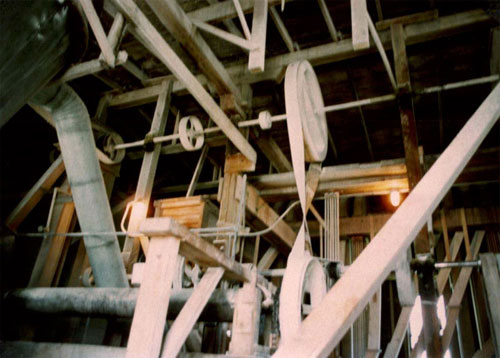
Interior view of the mill showing part of the elaborate drive system.
(Harrison Family Photo)
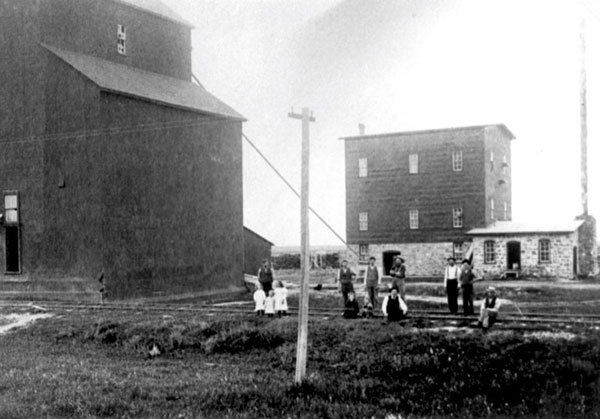
The mill, shortly after construction, ca. 1897. (Harrison Family Photo)

|
